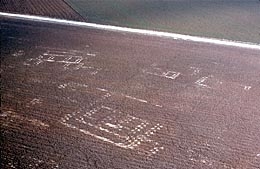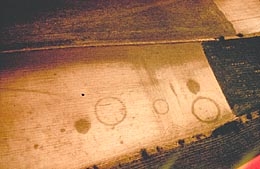- Home
- Clues on the ground
- Coming to the surface
A very large ashy zone corresponding to a vanished medieval hamlet laid over a Gallo-Roman sanctuary. Chipilly (Somme).
Near the ancient Roman road, deep plowing has brought to the surface elements of a Gallo-Roman sanctuary. Vermand-Marteville (Somme).
Deep plowing has brought the earthy rubble used to fill in the pits and circular ditches of a Bronze Age necropolis at Bailleul (Somme).
After plowing, and deep plowing in particular, anomalies in soil color (soil marks) will appear either in damp, foggy periods or after heavy rain, because the plow blades will bring up chalky elements from a building's foundations. The overall layout of ancient structures is thus perfectly visible. Deep plowing can also bring more clayish soil to the surface. The contrasts that reveal what is beneath are completely different. All of the structural drawings that appear in the Atlas d'archéologie aérienne de Picardie (Agache and Bréart, 1975) have been established in this manner.
This work is considerably helped by the fact that in the winter plowed fields are bare and easy to access. It is basically thanks to these soil marks that the floor-plans of Gallo-Roman structures are now so well known in the fertile fields of Picardy and Artois. Paradoxically, a large number of leveled remains were found in these rich, silty fields, although one would think that only poor, shallow soil was conducive to aerial prospecting.
Clues from toponyms
We have known for some time now that the toponym [Black Fields] is characteristic of soils with a high ash or humus content that mark the location of large, long-vanished structures. These ashy zones can often be seen from far off, and especially when one is looking into the light.
It is also common that they are only visible from a certain angle.



